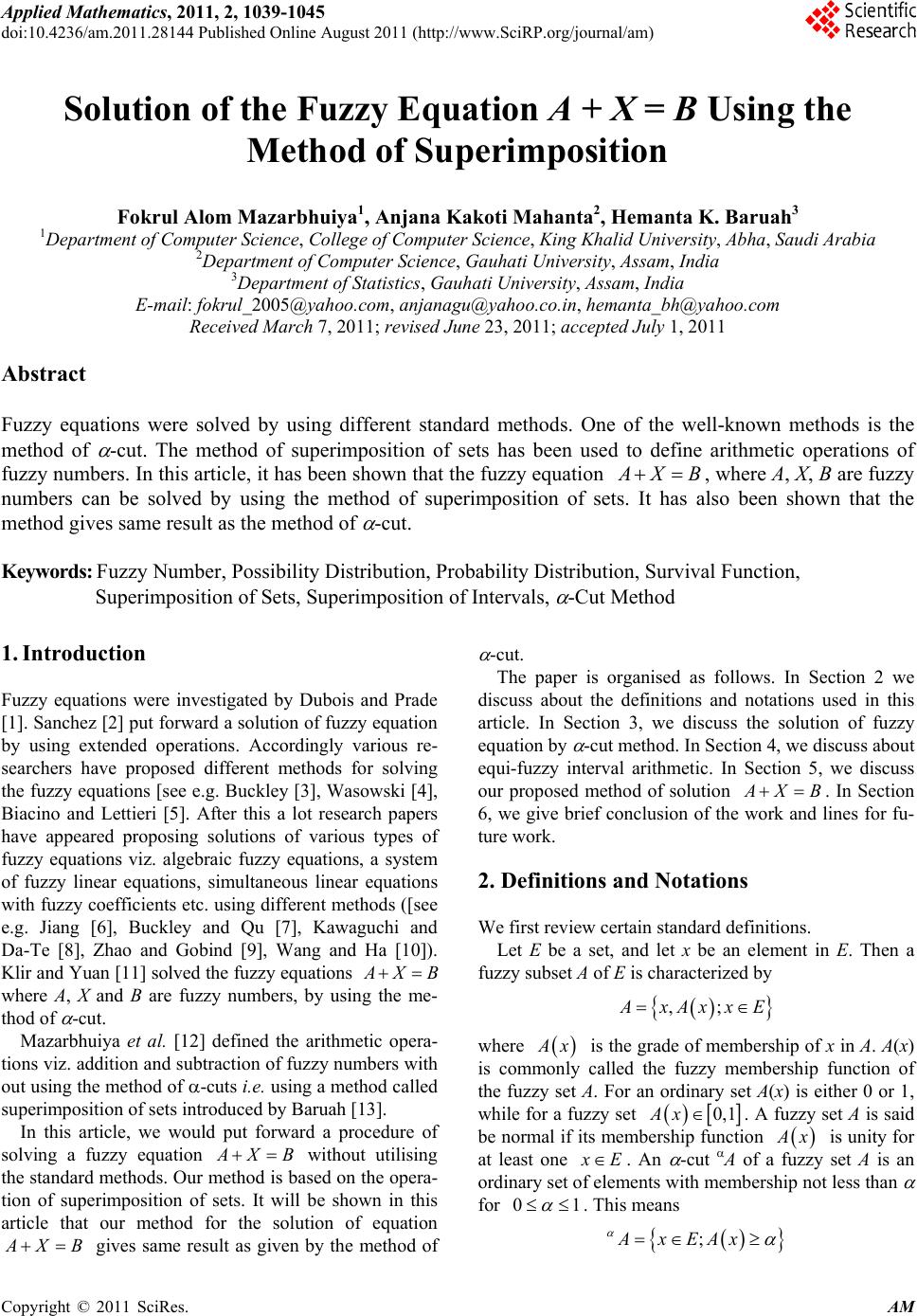 Applied Mathematics, 2011, 2, 1039-1045 doi:10.4236/am.2011.28144 Published Online August 2011 (http://www.SciRP.org/journal/am) Copyright © 2011 SciRes. AM Solution of the Fuzzy Equation A + X = B Using the Method of Superimposition Fokrul Alom Mazarbhuiya1, Anjana Kakoti Mahanta2, Hemanta K. Baruah3 1Department of Com p ut er Sci ence, College of Computer Science, King Khalid University, Abha, Saudi Arabia 2Department of Com p ut er Sci ence, Gauhati University, Assam, India 3Department of Stat i s t i c s, Gauhati University, Assam, India E-mail: fokrul_2005@yahoo.com, anjanagu@yahoo.co.in, hemanta_bh@yahoo.com Received March 7, 2011; revised June 23, 2011; accepted July 1, 2011 Abstract Fuzzy equations were solved by using different standard methods. One of the well-known methods is the method of -cut. The method of superimposition of sets has been used to define arithmetic operations of fuzzy numbers. In this article, it has been shown that the fuzzy equation AX B , where A, X, B are fuzzy numbers can be solved by using the method of superimposition of sets. It has also been shown that the method gives same result as the method of -cut. Keywords: Fuzzy Number, Possibility Distribution, Probability Distribution, Survival Function, Superimposition of Sets, Superimposition of Intervals, -Cut Method 1. Introduction Fuzzy equations were investigated by Dubois and Prade [1]. Sanchez [2] p ut forward a solu tion of fuzzy equation by using extended operations. Accordingly various re- searchers have proposed different methods for solving the fuzzy equations [see e.g. Buckley [3], Wasowski [4], Biacino and Lettieri [5]. After this a lot research papers have appeared proposing solutions of various types of fuzzy equations viz. algebraic fuzzy equations, a system of fuzzy linear equations, simultaneous linear equations with fuzzy coefficients etc. using different methods ([see e.g. Jiang [6], Buckley and Qu [7], Kawaguchi and Da-Te [8], Zhao and Gobind [9], Wang and Ha [10]). Klir and Yuan [11] solved the fuzzy equations X where A, X and B are fuzzy numbers, by using the me- thod of -cut. Mazarbhuiya et al. [12] defined the arithmetic opera- tions viz. addition and subtraction of fuzzy numbers with out using the method of -cuts i.e. using a method called superimposition of sets introduced by Baruah [13]. In this article, we would put forward a procedure of solving a fuzzy equation XB without utilising the standard methods. Ou r method is based on the op era- tion of superimposition of sets. It will be shown in this article that our method for the solution of equation XB gives same result as given by the method of -cut. The paper is organised as follows. In Section 2 we discuss about the definitions and notations used in this article. In Section 3, we discuss the solution of fuzzy equation by -cut method. In Section 4, we discuss about equi-fuzzy interval arithmetic. In Section 5, we discuss our proposed method of solution XB . In Section 6, we give brief conclusion of the work and lines for fu- ture work. 2. Definitions and Notations We first review certain standard definitions. Let E be a set, and let x be an element in E. Then a fuzzy subset A of E is characterized by ,; xAxxE where x is the grade of membership of x in A. A(x) is commonly called the fuzzy membership function of the fuzzy set A. For an ordinary set A(x) is either 0 or 1, while for a fuzzy set 0,1Ax. A fuzzy set A is said be normal if its membership function x is unity for at least one E . An -cut A of a fuzzy set A is an ordinary set of elements with membership not less than for 01 . This means ;AxEAx 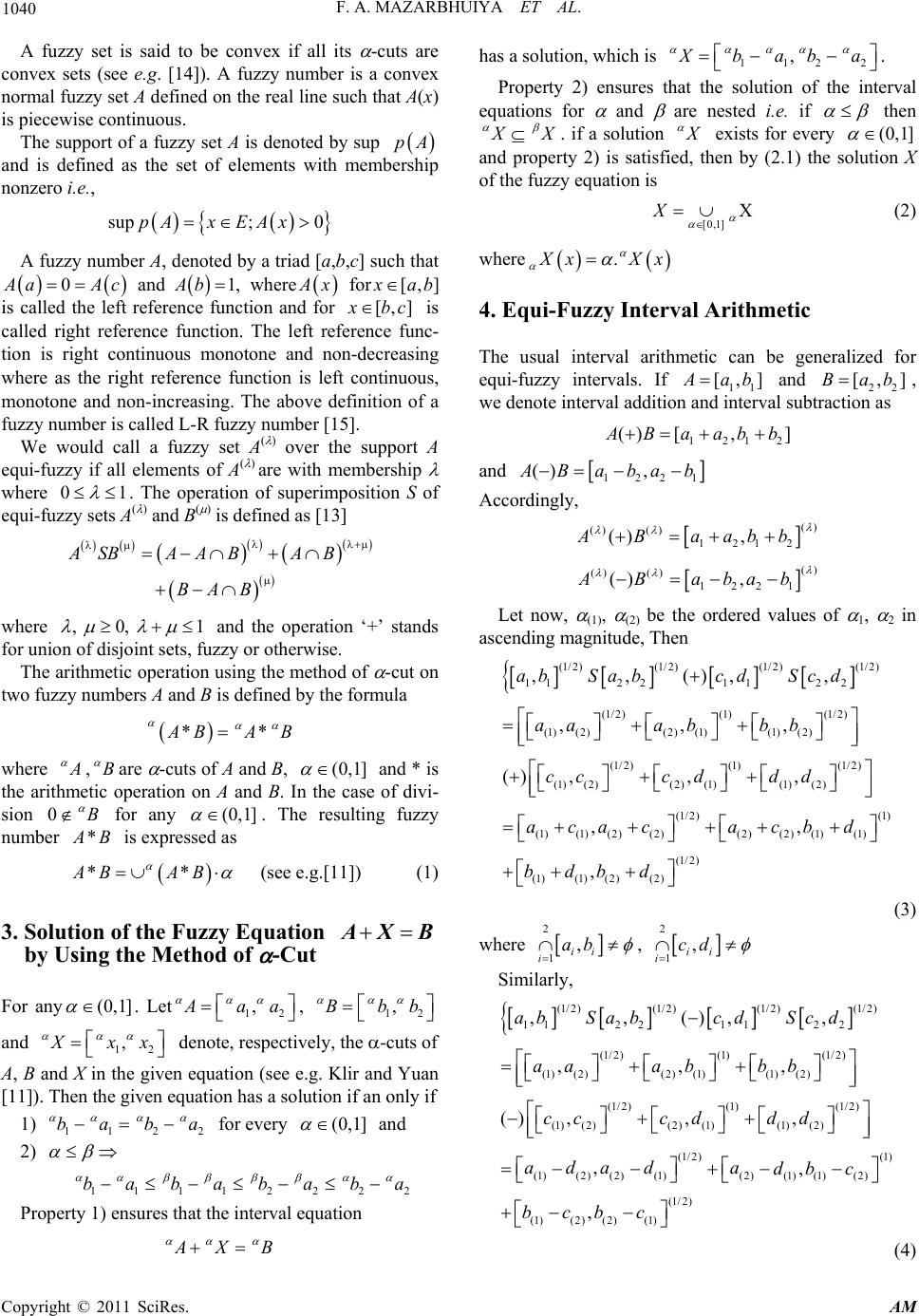 1040 F. A. MAZARBHUIYA ET AL. A fuzzy set is said to be convex if all its -cuts are convex sets (see e.g. [14]). A fuzzy number is a convex normal fuzzy set A defined on the real line such that A(x) is piecewise continuous. The support of a fuzzy set A is denoted by sup pA and is defined as the set of elements with membership nonzero i.e., sup; 0pAx EAx A fuzzy number A, denoted by a triad [a,b,c] such that 0 aA c and 1 b, where x for[,] ab is called the left reference function and for [,] bc is called right reference function. The left reference func- tion is right continuous monotone and non-decreasing where as the right reference function is left continuous, monotone and non-increasing. The above definition of a fuzzy number is called L-R fuzzy number [15]. We would call a fuzzy set A( ) over the support A equi-fuzzy if all elements of A( ) are with membership where 01 . The operation of superimposition S of equi-fuzzy sets A( ) and B( ) is defined as [13] ASBAABA B BAB where , 0, 1 and the operation ‘+’ stands for union of disjoint sets, fuzzy or otherwise. The arithmetic operation using the method of -cut on two fuzzy numbers A and B is defined by the formula ** BA B where ,are -cuts of A and B, B (0,1] and * is the arithmetic operation on A and B. In the case of divi- sion for any 0 B(0,1] . The resulting fuzzy number * B is expressed as **AB AB (see e.g.[11]) (1) 3. Solution of the Fuzzy Equation XB by Using the Method of -Cut For any(0,1] . Let12 , aa , and 12 ,Bbb 1 ,2 xx denote, respectively, the -cuts of A, B and X in the given equation (see e.g. Klir and Yuan [11]). Then the given equation has a solution if an only if 1) for every 11 2 baba 2(0,1] and 2) 1111222 babababa 2 Property 1) ensures that the interval equation XB has a solution, which is 112 2 , baba . Property 2) ensures that the solution of the interval equations for and are nested i.e. if then X . if a solution exists for every (0,1] and property 2) is satisfied, then by (2.1) the solution X of the fuzzy equation is [0,1] X X (2) where . xX x 4. Equi-Fuzzy Interval Arithmetic The usual interval arithmetic can be generalized for equi-fuzzy intervals. If 11 [,] ab and 22 [,]Bab , we denote interval addition and interval subtraction as 1212 () [,] Baabb and 1221 () , Babab Accordingly, () ()() 1212 () ,ABaabb () ()() 1221 () ,ABabab Let now, (1), (2) be the ordered values of 1, 2 in ascending magnitude, Then (1/2) (1/2)(1/2)(1/2) 112 21 122 (1/2)(1)(1/2) (1)(2)(2)(1)(1)(2) (1/2) (1)(1/2) (1)(2)(2) (1)(1) (2) (1/2) (1)(1)(2)(2) ,,(),, ,,, () ,,, , ab SabcdScd aaabbb cccd dd acac a (1) (2)(2)(1)(1) (1/2) (1)(1) (2)(2) , , cbd bdbd (3) where 2 1, ii iab , 2 1, ii icd Similarly, (1/2)(1/2)(1/2) (1/2) 112 21 122 (1/2)(1) (1/2) (1)(2)(2)(1)(1) (2) (1/2)(1)(1/2) (1)(2)(2)(1)(1)(2) (1/2) (1)(2)(2)(1) ,,(),, ,,, () ,,, , ab SabcdScd aaabbb cccd dd adad a (1) (2)(1)(1)(2) (1/2) (1)(2) (2)(1) , , db c bcbc (4) Copyright © 2011 SciRes. AM  F. A. MAZARBHUIYA ET AL. 1041 In the next section, we shall use (3) and (4) to find the solution X of the fuzzy equation XB . 5. Solution of the Fuzzy Equation XB by Using the Method of Superimposition Let 12 are sample realisations from the uniform population 11 and 12 ,,, n aa a [,uv],,, n bb b are sample realisa- tions from the uniform population . 11 We denoteas the superimpositions of equi- fuzzy intervals [, ; with membership (1/n) i.e. [, ]vw , n n Gab i ab] i1, 2,,i (1/ ) (1/ )(1/ ) 112 2 (1/) (2/) (1)(2) (2)(3) ((1)/ )(1) (1)()() (1) (11/ )(2/ ) (1)(2)(2)( 1) (1/ ) (1) () ,, ,, ,, ,, ,..., , n nn nn nn nn nn n n nn n nn GababSa bSSa b aa aa aa ab bbb b bb Ha ,(say)b (5) where are ordered values of 12 ,,, n aa a 12 ,,, n aa a 12 ,,, n bb b and are ordered values of 12 ,,, n bb b in ascending magnitude. Here n 1[,] ii iab From (5), we get the membership functions are the combination of empirical probability distribution function and complementary probability distribution function re- spectively as (1) 1(1) () 0, 1, 1, rr n xa r() axa n xa and (1) 2(1) () 1, 1 1, 0, rr n xb r() bxb n xb It is known that the Glivenko-Cantelli lemma of Order Statistics [16] states that the mathematical expectation of empirical distribution function is the theoretical probabil- ity distribution function and that of empirical comple- mentary probability distribution the theoretical survival function. Thus 11 ,ExPu and 2 1,Ex Pv 1 x (6) where 1 1 11 11 1 0, ,, 1, xu xu Pu xuxv vu xv 1 is the uniform probability distribution function on . and 11 [,]uv 1 1 11 11 1 0, ,, 1, xv xv Pv xvxw wv xw 1 is the uniform probability distribution function on . 11 From (5) using (6) we get the membership grades in [, ]vw ,Gabwhich is nothing but , ab can be estimated by the membership function 11 111 11 111 11 0, , , 1, xuxw xu Axux v vu xv vxw wv (7) where 111 [,, ] uvw is a fuzzy number. Again let 12 n ,,, xx are sample realisations from the uniform population 22 [, and 12 ]uv,,, n yy y [,v are sample realisations from the uniform population ]. 22 We denote w ,yGx as the superimposition of equi- fuzzy intervals [, ] ii y;1,2,,in with membership (1/n) i.e. (1/ ) (1/) (1/) 1122 (1/ )(2/ ) (1)(2) (2)(3) (( 1)/)(1)(11/) (1) ()()(1)(1)(2) (2/) (1/) (2) (1)(1)() ,, ,, ,,... ,,, ... ,, n nn nn nn nn n nn n nn nn nn Gxyx ySxySSxy xx xx xxxy yy yy yy Hx ,y (8) where 12 ,,, n xx , n are the ordered values of 12 ,, xx yy and 12n ,,,y are the ordered values of 12 ,,, n yyy in ascending order of magnitude and here x Copyright © 2011 SciRes. AM 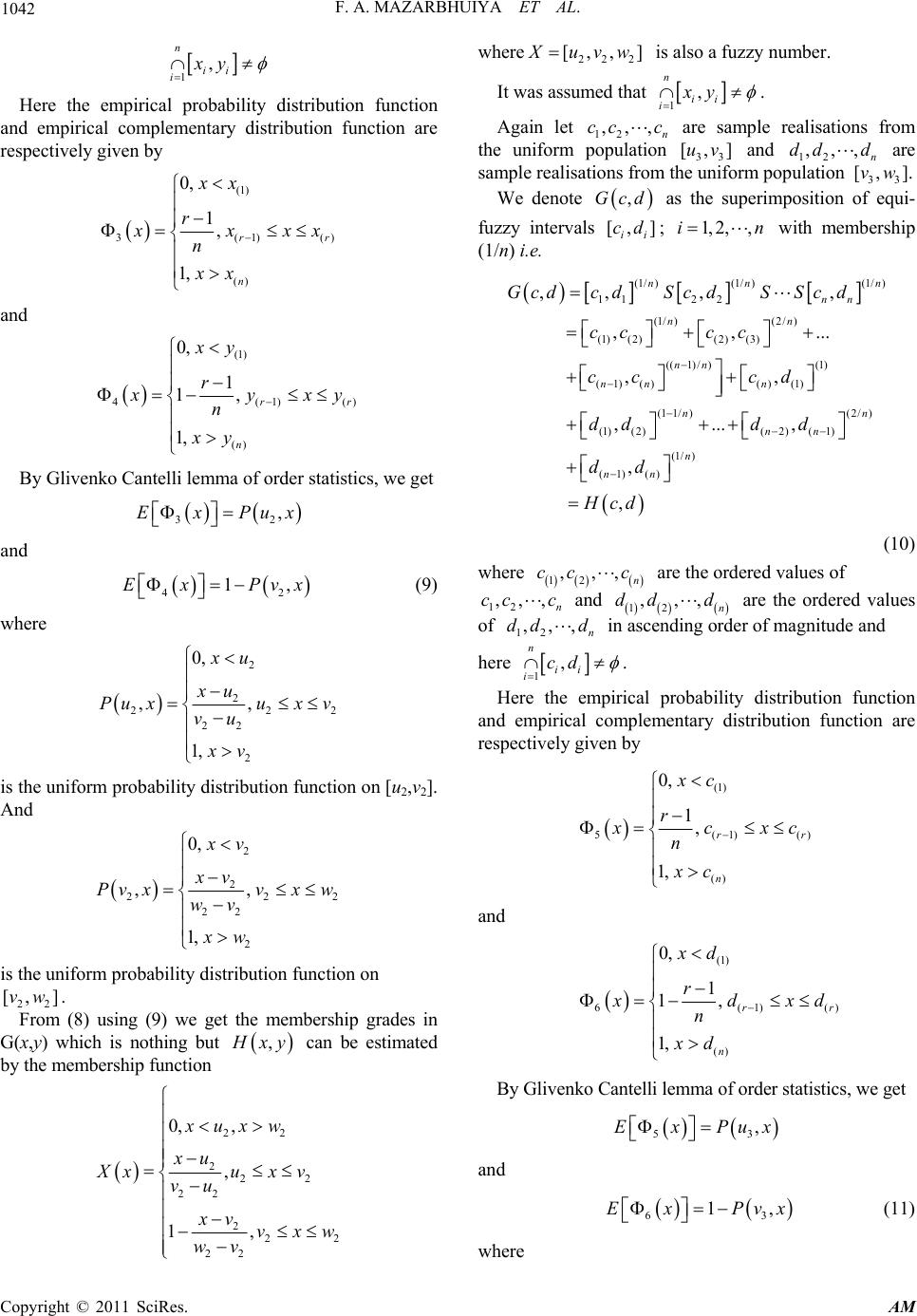 1042 F. A. MAZARBHUIYA ET AL. 1, n ii ixy Here the empirical probability distribution function and empirical complementary distribution function are respectively given by (1) 3(1) () 0, 1, 1, rr n xx r() xxx n xx and (1) 4(1) () 0, 1 1, 1, rr n xy r() yxy n xy By Glivenko Cantelli lemma of order statistics, we get 32 ,ExPu x 2 x and 4 1,Ex Pv (9) where 2 2 22 22 2 0, ,, 1, xu xu Pu xuxv vu xv 2 is the uniform probability distribution function on [u2,v2]. And 2 2 22 22 2 0, ,, 1, xv xv Pv xvxw wv xw 2 is the uniform probability distribution function on . 22 From (8) using (9) we get the membership grades in G(x,y) which is nothing but [, ]vw , xy can be estimated by the membership function 22 222 22 222 22 0, , , 1, xuxw xu Xxuxv vu xv vxw wv e22 2 [,, ] uvw wher is also a fuzzy number. It was assumed that 1, n ii ixy . Again let 12 ,,, n cc c population are sample realisations from the uniform and 33 [,]uv 12 ,,, n dd d pulation [,vw are sample realisationsorm po We denote from the unif33 ]. ,Gcd as the superimposition of equi- intervals fuzzy ] i ; 1,2,,in[, i cd with me (1/n) i. mbership e. (10) where (1/ ) ,, n Gcd cdS (1/ ) (1/ ) 112 2 (1/ (2) (1) () / ) (1)(2) (2)(1) (1/ ) (1) () , , ... , ,... , n n nn n nn nn nn n nn Sc dSc d c d d dd Hc ,d )(2/) (1)(2) (3) ((1)/ )(1) ,, n nn cc c c ()(1) , n ccd (1 1(2/ ) ,d d 12 ,,, n cc c , n c are the ordered values of 12 ,,cc and dd 12 ,,, n d are the ordered values of 12 ,,, n dd d in ascend n ing order of magnitude and here 1, ii icd . Here the empirical probability distribution function and empirical complementary distribution function given by are respectively (1) 5(1)() 0, rr xc () 1, n 1, r cxc n xc and (1) 6(1)() () 0, 1 1, 1, rr n xd r dxd n xd antelli lemma of order statistics, we get By Glivenko C 53 ,ExPu x and 63 1,Ex Pv x (11) where Copyright © 2011 SciRes. AM 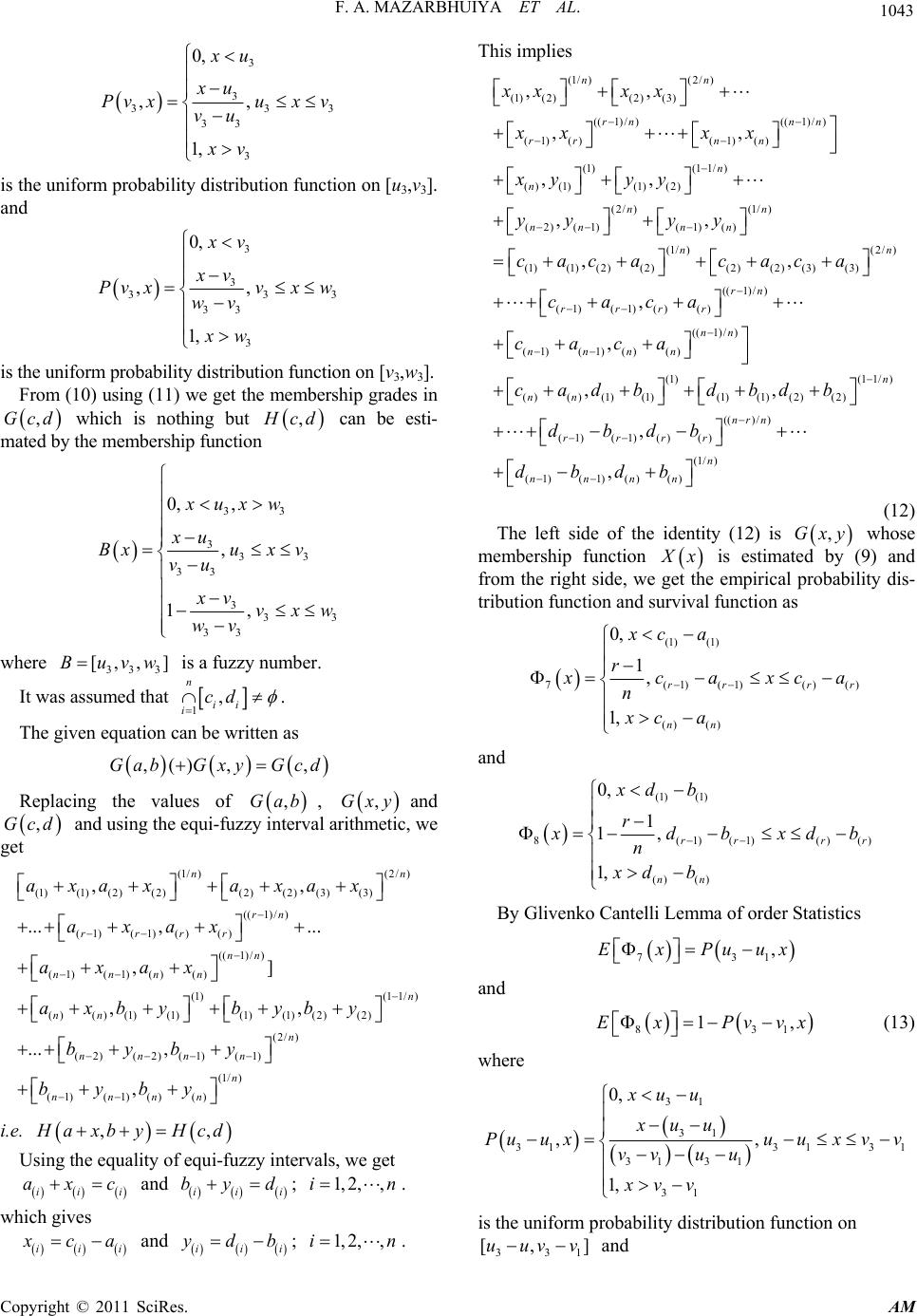 F. A. MAZARBHUIYA ET AL. 1043 3 3 33 33 3 3 ,, 1, xu Pv xux v vu xv is the uniform probability distribution function on 3 3 0, xu [u,v]. and 3 3 33 33 3 0, ,, 1, xv xv Pv xvxw wv xw 3 is the uniform probability distribution function on [v3,w3]. From (10) using (11) we get the membership grades in ,Gcd which is nothing but , cd can be esti- the membership func tion mated by 33 333 33 0, ,xuxw xu xw where is a fuzzy number. It was assumed that 333 33 1, xv v wv ,Bx ux v vu 33 3 [,, ]Buvw 1, n ii icd . The given equation can be written as Replacing the values of , and and using the equi-f interval arithm we i.e. ,(),,GabGxyGcd ,Gab uzzy ,Gxy etic, ,Gcd get (1/) (2/) (2)) (3)(3) ((1)/ ) ( 1)( 1)()() (1 1/ () , . ,] nn nn nnnn n axax axax a (2/ ) (2)(2)(1)(1) (1/ ) (1) (1)()() , , n nnnn n nnnn byby byby (1)(1) (2)(2)(2 ,axax (( 1)/ ) ( 1)( 1)()() ... ,.. rn rr rr ax ax (1) ) ()(1)(1)(1)(1)(2)(2) ,, . n n x bybyby .. ,, axby Hcd Using the equality of equi-fuzzy intervals, we get i and i which gives i ii axc ii byd; 1, 2,,in. ii ca and This implies (12) The left side of the identity (12) is whose membership function ii ydb; i1, 2,,in. (1/) (2/) (1) (2)(2) (3) ((1)/)((1)/ ) (1) ()(1) () (1)(1 1/) () (1)(1) (2) (2/) (1/) (2)(1) (1)() (1)(1) (2) ,, ,, ,, ,, , nn rn nn rr nn n n nn nn nn xx xx xx xx xy yy yy yy cac (1/)(2/ ) (2)(2) (2)(3) (3) ((1)/ ) (1)(1)()() ( 1)( 1)() (1)(11/) (1)(1) (1)(1)(2)(2) ) ( , , nn rn rrrr nn n n r acaca caca dbdbdb db (()/ ) 1) ()() (1/ ) ( 1)( 1)()() , , nr n rr n nnnn db dbdb (( 1)/ ) ,nn ca ca ()n ( )() ,, nn ca (1r ,Gxy x is estim from the right side, we get the em tribution function and survival function as ated by (9) and pirical probability dis- (1) (1) 7(1)(1)() () () 0, 1, 1, rr r nn xc a r()r ca xca n xc a and (1) (1) 8(1)(1) () () 0, 1 1, 1, rrr nn xd b r()()r dbxdb n xdb By Glivenko Cantelli Lemma of order Statistics P 731 ,Ex uux and 83 1,Ex Pvv 1 x (13) where 31 31 3131 31 31 31 31 0, ,, 1, xu u xuu Pu uxu uxvv vv uu xv v is the uniform probability distribution function on 1 ] 33 [,uuvv and Copyright © 2011 SciRes. AM 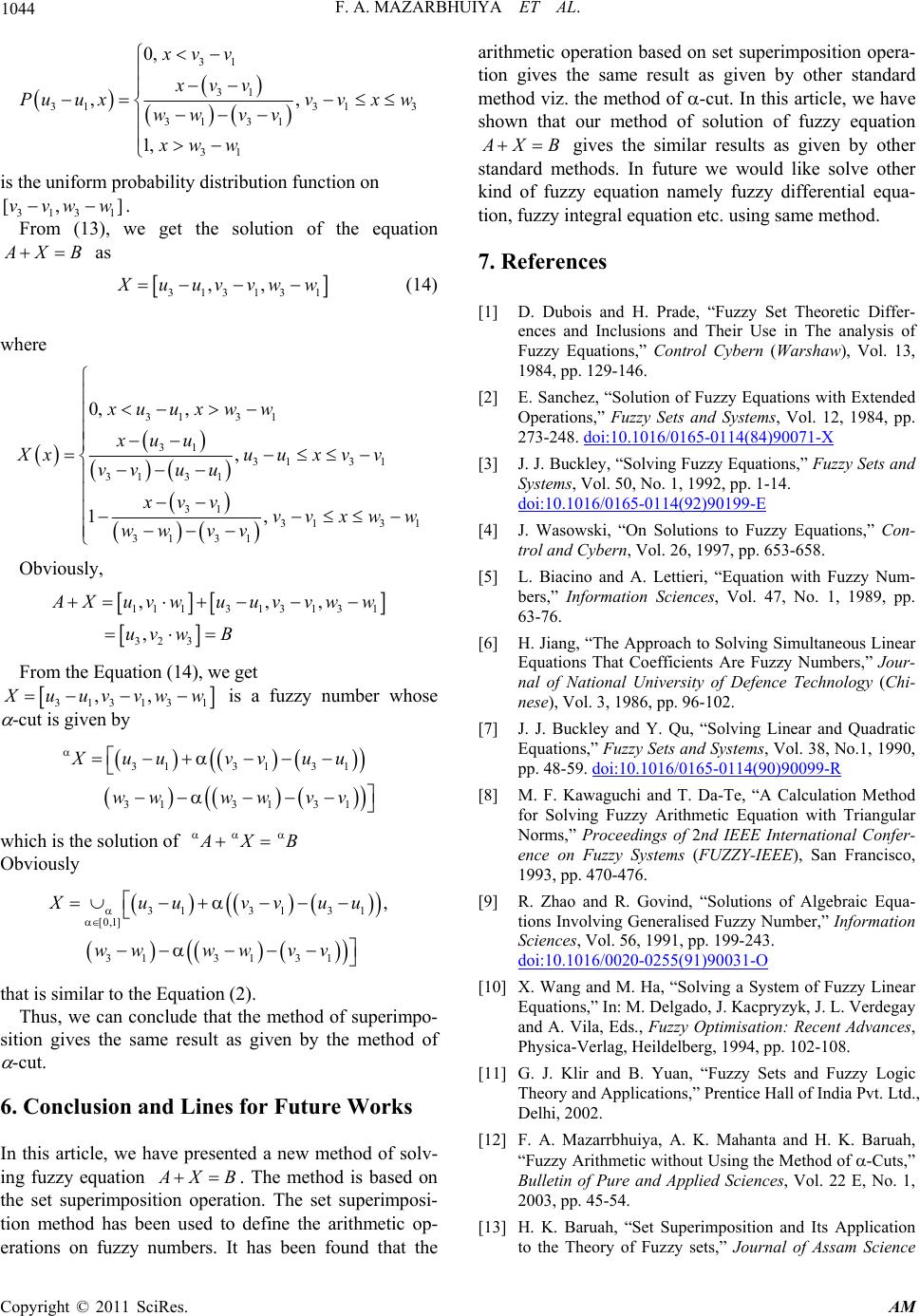 1044 F. A. MAZARBHUIYA ET AL. 31 31 31 31 31 31 31 0, ,, 1, xv v xvv Puu xvvx3 ww vv xw w is ] From (13), we get the solution of the equation w the uniform probability distribution function on 313 1 [,vvww. XB as 31313 1 ,, uuvvww (14) where 313 1 31 31 31 31 313 1 31 31 0, , , 1, xu uxww xuu Xxuux vv vv uu vvxww ww vv Obviously, 31 3 1 xvv 111313131 323 ,,, , Xuvw uuvvww uv wB From the Equation (14) , we g et 31313 1 ,, uuvvww -is a fuzzy number whose cut is given by 3131 3 3131 31 Xuuvvuu wwww vv he solution of 1 which is t XB Obviously 3131 31 [0,1] 3131 31 ,Xuuvvuu wwww vv that is similar to the Equation (2). Thus, we can conclude that the method of superimpo- sition e result as given by the method 6. Conclusion and Lines for Future Works In new method of solv- ing fuzzy equation gives the sam -cut. of this article, we have presented a XB. The method is based on he set superimpoation. The set superimposi- ethod has bee tsition oper tion mn used to define the arithmetic op- erations on fuzzy numbers. It has been found that arithmetic operation based on set superimposition opera- tion gives the same result as given by other standard method viz. the method of -cut. In this article, we have shown that our method of solution of fuzzy equation the XB gives the sismilar results a given by other ethods. In future we would like solve other equation namely fuzzy differential equa- integral equation etc. using same method. p. 129-146. ed p. standard m kind of fuzzy tion, fuzzy 7. References [1] 84, p D. Dubois and H. Prade, “Fuzzy Set Theoretic Differ- ences and Inclusions and Their Use in The analysis of Fuzzy Equations,” Control Cybern (Warshaw), Vol. 13, 19 [2] E. Sanchez, “Solution of Fuzzy Equations with Extend Operations,” Fuzzy Sets and Systems, Vol. 12, 1984, p 273-248. doi:10.1016/0165-0114(84)90071-X [3] J. J. Buckley, “Solving Fuzzy Equations,” Fuzzy Sets and Systems, Vol. 50, No. 1, 1992, pp. 1-14. doi:10.1016/0165-0114(92)90199-E [4] J. Wasowski, “On Solutions to Fuzzy Equations,” Con- trol and Cybern, Vol. 26, 1997, pp. 653-658. [5] L. Biacino and A. Lettieri, “Equation with Fuzzy Num- bers,” Information Sciences, Vol. 47, No. 1, 1989, pp. 63-76. [6] H. Jiang, “The Approach to Solving Simultaneous Linear ions That Coefficients Are Fuzzy Numbers,” Jour- nal of National University of Defence Technology (Chi- nese), Vol. 3, 1986, pp. 96-102. [7] J. J. Buckley and Y. Qu, “Solving Linear and Quadr Equations,” Fuzzy Sets and Systems, Vol. 38, No.1, 1990 Equat atic , 10.1016/0165-0114(90)90099-Rpp. 48-59. doi: nd T. Da-Te, “A Calculation Method [8] M. F. Kawaguchi a for Solving Fuzzy Arithmetic Equation with Triangular Norms,” Proceedings of 2nd IEEE International Confer- ence on Fuzzy Systems (FUZZY-IEEE), San Francisco, 1993, pp. 470-476. [9] R. Zhao and R. Govind, “Solutions of Algebraic Equa- tions Involving Generalised Fuzzy Number,” Information Sciences, Vol. 56, 1991, pp. 199-243. doi:10.1016/0020-0255(91)90031-O [10] X. Wang and M. Ha, “Solving a System of Fuzzy Linear Equations,” In: M. Delgado, J. Kacpryzyk and A. Vila, Eds., Fuzzy Optimisatio, J. L. Verdegay n: Recent Advances, uzzy Logic azarrbhuiya, A. K. Mahanta and H. K. Baruah, ition and Its Application Physica-Verlag, Heildelberg, 1994, pp. 102-108. [11] G. J. Klir and B. Yuan, “Fuzzy Sets and F Theory and Applications,” Prentice Hall of India Pvt. Ltd., Delhi, 2002. [12] F. A. M “Fuzzy Arithmetic without Using the Method of -Cuts,” Bulletin of Pure and Applied Sciences, Vol. 22 E, No. 1, 2003, pp. 45-54. [13] H. K. Baruah, “Set Superimpos to the Theory of Fuzzy sets,” Journal of Assam Science Copyright © 2011 SciRes. AM  F. A. MAZARBHUIYA ET AL. Copyright © 2011 SciRes. AM 1045 ation -0255(83)90025-7 Society, Vol. 10, No. 1-2, 1999, pp. 25-31. [14] G. Q. Chen, S. C .Lee and S. H. Yu Eden, “Applic Sett of Fuzzy Set Theory to Economics,” In: P. P. Wang, Ed., Advances in Fuzzy Sets, Possibility Theory, and Applica- tions, Plenum Press, New York, 1983, pp. 277-305. [15] D. Dubois and H. Prade, “Ranking Fuzzy Numbers in the ing of Possibility Theory,” Information Science, Vol. 30, No. 3, 1983, pp. 183-224. doi:10.1016/0020 [16] M. Loeve, “Probability Theory,” Springer Verlag, New York, 1977.
|